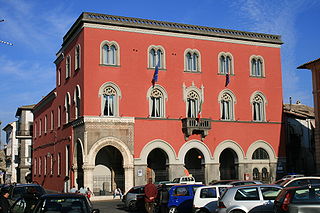
Lake Bracciano is a lake of volcanic origin in the Italian region of Lazio, 32 km (20 mi) northwest of Rome. It is the second largest lake in the region and one of the major lakes of Italy. It has a circular perimeter of approximately 32 km (20 mi). Its inflow is from precipitation runoff and percolation, and from underground springs, and its outflow is the Arrone.

Fiumicino is a town and comune in the Metropolitan City of Rome, Lazio, central Italy, with a population of 80,500 (2019). It is known for being the site of Leonardo da Vinci–Fiumicino Airport, the busiest airport in Italy and the eleventh-busiest in Europe.

Bracciano is a small town in the Italian region of Lazio, 30 kilometres northwest of Rome. The town is famous for its volcanic lake and for a particularly well-preserved medieval castle Castello Orsini-Odescalchi. The lake is widely used for sailing and is popular with tourists; the castle has hosted a number of events, especially weddings of actors and singers.

Magasa is a town and comune in the province of Brescia, in Lombardy in northern Italy.

Trevignano Romano is a small town and comune in the Metropolitan City of Rome, Lazio, central Italy. With a population of about 5,000, it is located on the volcanic Lake Bracciano. It is about 47 kilometres (29 mi) away from Rome.

Lake Martignano, is a small lake in Lazio, Italy 24 kilometres (15 mi) north-north-west of Rome, in an extinct crater or maar. Administratively its coast is divided amongst the municipalities of Rome, Anguillara Sabazia and Campagnano di Roma.

Monterosi is a comune (municipality) in the Province of Viterbo in the Italian region Lazio, located about 30 km (18,64 mi) north of the Grande Raccordo Anulare of Rome, about 40 km (24,85 mi) south of Viterbo.

Anguillara Sabazia is a town and comune in the Metropolitan City of Rome, Lazio, central Italy, around 30 kilometres (19 mi) northwest of Rome. It nestles on a small cape on the coast of Lake Bracciano; its medieval center and its beach make it a popular destination for tourists.

Campagnano di Roma is a comune (municipality) in the Metropolitan City of Rome in the Italian region of Latium, located about 30 kilometres northwest of Rome. It was first mentioned in 1076, having been carved out of the great estate assembled on the Roman pattern by Pope Adrian I, ca. 780, his Domusculta Capracorum. In medieval times, Campagnano di Roma was on the via Francigena. Here, Sigeric, Archbishop of Canterbury, sojourned on his return journey from Rome about 990.

Sacrofano is a comune (municipality) in the Metropolitan City of Rome in the Italian region of Latium, located about 25 kilometres (16 mi) north of Rome. Located near the Monti Sabatini, at the feet of an extinct volcano, it is included in the Regional Park of Veii.

Anguillara were a baronial family of Latium, especially powerful in Rome and in the current province of Viterbo during the Middle Ages and the early Renaissance.

Cesano is the 52nd zona of Rome, Italy, identified by the initials Z. LII. It takes its name from the small medieval village of Cesano di Roma, on the Via Cassia, which is located within the Municipio XV, 27 km from Rome proper.

Settecamini is the 6th zona of Rome, identified by the initials Z. VI.. Settecamini is also the name of the urban zone 5L, within the Municipio V of Rome.

Ponte Galeria is the 41st zona of Rome, Italy, identified by the initials Z. XLI. Geographically it was part of Agro Romano. The zone belongs to the Municipio XI.
Il commissario Manara is an Italian detective television series. It is a spin-off of Una famiglia in giallo, and like that show, is a romantic comedy and a police procedural. Guido Caprino plays the titular commissioner Luca Manara.

Bernardino Lunati (1452–1497) was an Italian Roman Catholic cardinal.

The FL3 is a commuter rail route. It forms part of the network of the Lazio regional railways, which is operated by Trenitalia, and converges on the city of Rome, Italy.
The Duchy of Bracciano was a fief of the Papal States, centred on lago di Bracciano and the town of Bracciano itself and ruled by a branch of the Orsini family with the title of Lord and Duke (1560–1696).

The Visconti Castle of Invorio was a mediaeval castle located in Invorio, Province of Novara, Piedmont, northern Italy. Only a tower today survives, surrounded by the traces of the ancient walls. Matteo I Visconti, Lord of Milan, was born there in 1250.

The zones of Rome are toponymic subdivisions within the area of the Ager Romanus, belonging to the Municipalities of Rome and Fiumicino, Italy.


















